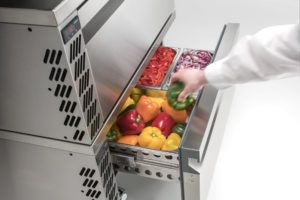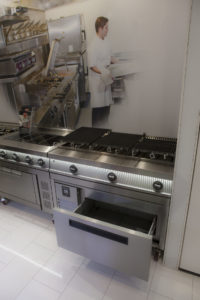There are so many disparate foodservice equipment manufacturers in the UK marketplace with so many individually-developed products that it can make it tough for dealers to know who to specify. But when multiple manufacturers work together to create complementary appliances, this can ease design challenges for dealers.
Therefore we quizzed a cross-section of suppliers to see who is helping to make distributors’ and operators’ lives easier with some joined-up thinking.
One tie-up which is particularly easy to action is between sister AFE Group companies, Falcon Foodservice Equipment and Williams Refrigeration. Falcon’s 20 shelf Lainox combis can now be used with the new Williams blast chillers. Both pieces of equipment have been designed specifically to be compatible with the Lainox 20 shelf trolleys.
Story continues below
Advertisement
In operation, staff can wheel a laden trolley from the combi oven straight into the blast chiller. The castors and bottom remain beneath the cabinet while the door design ensures a tight seal around the rest of the trolley. The blast chiller chills the piping hot food down to the designated holding temperature in 90 minutes or less, designed to ensure the food is safe and its quality is preserved.
In addition, the F900 and Dominator Plus countertop equipment is suited for location on top of Williams UBC and Chef’s Drawer models, designed to optimise use of space and be a standalone cooking station.
According to Falcon’s product development chef, Shaune Hall: “Caterers can benefit as Falcon can provide tried and tested solutions. There’s no need to worry that, for example, the cookline will be too high or that the fridge won’t support the weight. By being able to pair pieces of equipment this will also provide solutions to space issues.”
Plus the Lainox 171 – a seven grid combi mounted on top of a ten grid – can further help space restrictions, as both chambers are contained in a single body. “It delivers the flexibility of two separate units but, because it’s housed in one body, it’s shorter, and so safer, while both combis’ control panels are mounted at user-friendly heights,” commented Hall. The 171 is available in gas and electric in either top of the range Naboo touchscreen controls or the Sapiens manually-controlled models.
At Williams itself, much of its product range is stand-alone units in varying configurations, utilised for many different applications, which the manufacturer therefore believes can be used in conjunction with many other brands of equipment found in a commercial kitchen.
Williams’ Chef’s Drawers can be stacked on top of one another.Sales and marketing director Malcolm Harling emphasised: “Williams has a number of products within its range which are particularly suitable for pairing with other equipment. For example our low level Under Broiler Counters (UBC) range provides refrigerated storage directly below the cooking station. They can accommodate most suppliers of one piece tops and prime cooking equipment brands of heavy duty appliances such as chargrills and griddles.”
He added: “Our designs have led to providing a cook and chill solution for the operator. For example Williams UBC paired with a chargrill offers a great space-saving solution for compact kitchens. It also negates the need for transferring food from, for example, a coldroom to the cook face. The other benefit is that food remains chilled until the point of cooking.”

Plus the manufacturer’s range of Chef’s Drawers are stackable. Its latest model in the range, VWCD1 (launched in October 2019) allows the user to set the temperature of each stacked drawer as either a refrigerator or freezer. According to Harling: “Clever design has meant the new VWCD1 model has been built to a depth of just 670mm, thereby fitting perfectly within a standard 700mm work surface and taking into account the, often overlooked, extra 30mm required for plug sockets. Even though the new Drawer accommodates 2/1 GN storage with an impressive depth of 150mm, two stacked units with castors measure only 838mm in height and therefore fit perfectly beneath a 900mm-high work surface.”
Another cooking and refrigeration equipment collaboration is between Charvet and both Precision and Adande. The French manufacturer can house the latter pair’s refrigerated draws underneath its cooklines. Plus Charvet can incorporate custom rotating chargrills, robata grills, warming drawers and cabinets and water baths in its suites. Ian Clow, Charvet UK sales director, detailed: “We also work with a specialist commercial supplier of induction cooking hobs. The Induction Multizone 4 x 3.5kW hobs working independently or as one, was a result of this collaboration.
“By enabling the installation of multi-purpose cooking equipment such as the Multizone, this can be used for several purposes, just like the traditional solid top, but with much less impact on ventilation and energy bills.”

He added: “Furthermore, Charvet can make to order, for our distributor partners, recessed and ‘drop-in’ spaces for specialist equipment such as combi ovens. The advantage for users of the combi – typically a six or 10 grid model – is less bending down to load/ unload, improving ergonomics.”
Charvet’s modular One Series further features quick connecting strips which allow for the modular units to slot together more quickly and more accurately than previously, helping to speed up install times.
One headline-making team-up in 2019 was Synergy Grill Technology and Lincat. The manufacturers signed an agreement which allowed the Middleby Group company to offer Synergy Grill’s multi-patented technology within its Opus 800 series.
Prior to this agreement, Synergy Grill had never before allowed its British-made advanced grill technology to be used by another company. Richard Ebbs, commercial and marketing director at Synergy Grill Technology, commented: “By offering our pioneering technology with Lincat’s Opus 800 series, we are helping dealers to satisfy customer demand for suited kitchen solutions that don’t compromise on energysaving technology.
“The benefits of massive energy savings, cleaner, safer kitchens, cleaner ventilation shafts and above all higher food quality, are now being increasingly specified by a wide range of end users.”
Over in the warewashing sector, Winterhalter works alongside its sister brand Classeq, as well as a variety of glassware and crockery manufacturers. Paul Crowley, marketing development manager of Winterhalter UK, detailed: “By working closely with crockery companies Winterhalter can demonstrate how, through efficient warewashing and crockery design, the need for lots of storage can be reduced.”

He also revealed: “Winterhalter machines have, in the past, been paired with, of all things, a coffee machine! This meant that the equipment was able to share the same softened water. Generally, it is rare for these two products to be in the vicinity of each other.”
Bridging the gap between stationary and mobile appliances, Rieber’s self-ventilating mobile Varithek front cooking stations are said to be able to be paired with virtually any distributor’s fixed counter or servery scheme to create a bespoke front cooking experience.
BGL Rieber MD Gareth Newton recounted: “Rieber’s Varithek system was chosen by a leading distributor for its refurbishment of a major Premier League football club hospitality area because it solved a crucial ventilation issue in a public space.
“The lounge hosts a sumptuous running buffet for three hours before kick-off. The club wanted a front of house cooking station for stir-fries and to cater for its vibrant conference business including breakfast meetings and functions on non-match days. A conventional extract system was a nonstarter due to site layout restrictions and potential interference with the existing air conditioning systems. The self-ventilation system on Rieber’s Varithek solved the problem.”
The manufacturer also works closely with distributors using its EST system, which should allow for up to five Varithek GN 1/1 cooking modules to be installed into a counter. This is aimed at creating a multi-purpose counter which can hold food hot but can also cook when needed.
The EST is a tailor-made frame, which holds one to five cooking modules. It is suitable for refurbishments or new counters. Newton explained: “The distributor cuts the slot into the countertop and the EST frame sits over. It allows Rieber 1/1 induction or Ceran hobs, and griddles to simply slot in. The height of each module can be adjusted to create a flush surface.”
He summarised: “This collaboration benefits the distributor because building a hot food holding and front cooking solution into a counter design brings a highly productive and flexible cooking system and maximises use of space.”
Plus Rieber is a major maker of stackable, space-saving GN pans, sold by its distributor partners in the UK. Newton detailed: “Every distributor and any chef knows how hard it is to prise apart steel GN pans that have become stuck together. This frequently happens when pans come out of the dishwasher hot and are stacked, one on top of each other.
“Rieber’s patent pending development is a special ‘lug’ formed into each corner of its GN pans. The lug sits on the internal rim of the pan, enables space-saving stacking and easy unstacking because the pans are not allowed to nestle into each other. The lug also ensures air can get in and around the pan, helping with drying.”